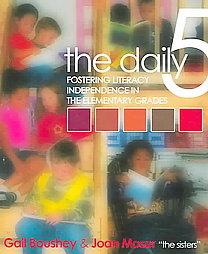Overview
Recently, I was given the opportunity to watch how two teachers have combined their primary classrooms and transitioned their students through a program called the Daily 5.
The Daily 5 is a program for structuring your classroom for differentiated instruction in language arts. Students are provided choice in choosing from five stations that they will transition through. It is an ambitious program that I have been told to not implement in your first year of teaching. However, this is a program that I would like to work my way up to as I mature as a teacher. Something that I took from the book was a table that the authors created. This table showed the progression of the teacher’s program, classroom management and classroom structure as the program developed and they matured in their teaching. I noted that the physical space changed drastically as the years went on. Most significantly to me was the change in the teacher’s desk. As the program progressed, the teacher’s desk area decreased until it was the same size as the other student’s desks.
Below are some observations of how the students were given independence and choice in their learning as they transitioned through five language arts stations.
Choice of activity
All students came together in the morning in a common area with their supplies. Each student had a set of supplies in a magazine holder (creative writing journal, worksheets, guided reading books, spelling words). The teachers gave a 10 minute instruction. Then students filled out a sheet about what 5 activities they would complete that morning. Occasionally, the teacher would inform a group that they were meeting with her during one of the activities. Once students had made their choices she set a timer and the students started their activity right away.
Choice in work space
Students were given numerous areas to work in; tables, floor, couches, and even different rooms. The teachers had noticed that students worked better when they sat in an area that was comfortable for them to complete their work. Occasionally, the teacher would ask students to move to a location that helped them to “take care of their learning” as it seemed that they had gotten off task.
Participation in physical activity
Once an activity was completed, a calm alarm sounded and students moved to their next activity. During this transition students had a choice to participate in daily activity. This included stepping up onto exercise balls or running outside towards a wall and back.
Choice in behaviour
The premise of the Daily 5 is that students have autonomy in their learning. Therefore, students are taught what positive and negative behaviours look like and are given an opportunity to practice. Students are also brought back to a common area in between activities to reflect on their behaviours and make goals for building stamina in their independent work. The teachers noted that although these lessons are time consuming, you build an expectation that students are responsible for their own behaviours and it eventually reduces the amount of corrections/reminders throughout the day by the teachers – less micromanaging.
The Daily 5 is a fantastic program that I would love to implement when I have my own classroom. I have heard that it works really well for primary classrooms. I am interested to discover intermediate classrooms that have used the daily five or if there are any programs that intermediate classrooms use that are similar to this program.

